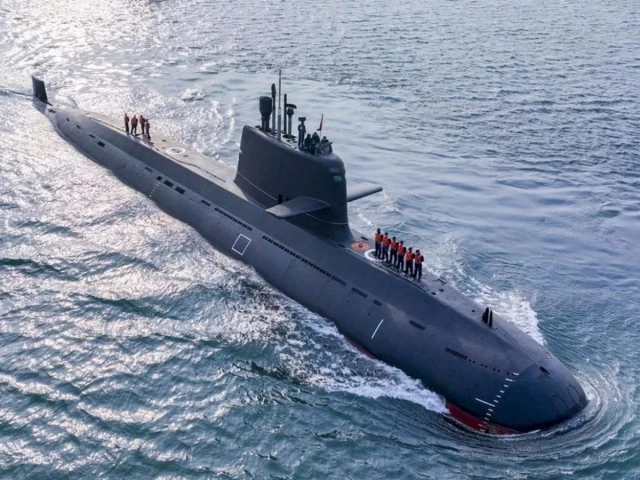Analysts say the Hangor-class submarines could challenge India’s naval dominance, particularly in the northern Arabian Sea.
Pakistan’s top naval official has confirmed that the first batch of China-built Hangor-class submarines will soon enter service, a move that analysts say could test India’s dominance in the Indian Ocean and marks a major technical milestone for Beijing.
Admiral Naveed Ashraf, Chief of Naval Staff, said World Time that conventionally powered attack submarines, co-developed by China and Pakistan, are expected to join the Pakistan Navy next year.
“The submarine program is progressing smoothly,” Ashraf said. He highlighted the ships’ role in strengthening Pakistan’s submarine capabilities, fostering “self-reliance through technology transfer and skills development” and reflecting close Sino-Pakistani collaboration in naval equipment.
Ashraf added that the Chinese-origin platforms were reliable, technologically advanced and suitable for the operational needs of the Pakistan Navy. He noted that emerging technologies, including unmanned systems, artificial intelligence and electronic warfare, are increasingly important, and Pakistan plans to continue its collaboration with China in these areas.
Pakistan is the world’s largest importer of Chinese weapons, accounting for 63% of Beijing’s global arms exports between 2020 and 2024, including naval systems. Islamabad has already received four Type 054 frigates, renamed Tughril class frigates, into its navy.
Analysts say the Hangor-class submarines could challenge India’s naval dominance, particularly in the northern Arabian Sea. Liselotte Odgaard of the Hudson Institute in Washington said the ships enhance Pakistan’s anti-access and area-denial capabilities and could support China’s maritime corridors to the Middle East, including the port of Gwadar.
“Hangor-class submarines significantly improve Pakistan’s deterrence posture, complicating India’s maritime strategy and contributing to China’s broader Indo-Pacific ambitions,” Odgaard said.
Pakistan currently operates five conventional attack submarines imported from France, while India deploys nuclear-powered missile submarines, including the INS Arihant and INS Arighaat, which can stay submerged longer and operate at higher speeds.
Jagannath Panda of the Stockholm-based Institute for Security and Development Policy said the Hangor-class fleet would “strengthen” Pakistan’s sea-denial position in the northern Arabian Sea and increase the costs of India’s anti-submarine operations.
The design of the Type 039A submarines allows for air-independent propulsion, allowing them to remain submerged for up to three weeks, with approximately 60 days of total mission duration. Odgaard noted that their torpedo tubes can launch anti-ship and submarine-launched cruise missiles, potentially giving Pakistan a second-strike nuclear capability.
The delivery delays are linked to Germany’s refusal to export the MTU396 engines due to a European Union arms embargo, forcing China to develop the CHD620 engine. Odgaard said this indicated that China had “largely resolved” supply chain constraints and could circumvent Western technological dependencies.
Experts warn, however, that the CHD620 engine still needs to prove itself in operational conditions, particularly in terms of noise and stealth performance, although the submarines are expected to offer reasonable capabilities at a lower cost than Western models.
Under a 2015 deal, Pakistan is to receive eight Hangor-class submarines, four from China and four produced locally under technology transfer deals. The $5 billion deal is Beijing’s largest arms export deal ever.




